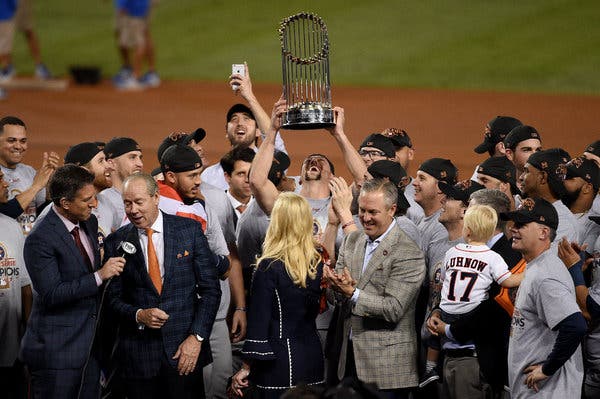At the heart of baseball’s sign-stealing scandal is the sport’s long struggle with technology and its inconsistent drawing of a line between gamesmanship and cheating.
Baseball’s mythos is immersed in cunning larceny and wily deceit. So is its vocabulary: Nice guys finish last. Bases are “stolen.” Balls (and some players) are “juiced.” The entire point of pitching is to elude batters with speed or crafty deception. In 1974, Gaylord Perry confessed in a midcareer autobiography to throwing a spitball and was still voted to the Vaseline wing of the Hall of Fame.
Artful trickery makes baseball endearing, helps keep it relevant. It is, at its essence, a game of boundless futility. Even the greatest hitters fail to get a hit seven of every 10 times at bat, a reminder that we are all hugely imperfect and must rely on shrewdness and cunning to succeed.
Well, to a point.
It is O.K. for base runners to steal a catcher’s signs, but not for anyone to use a television or computer to decipher the sequence of those finger-wagging signals. Then caginess is deemed an unfair advantage and, as we have seen in recent days, a fireable offense.
Baseball executives were the vanguard of the analytics movement in sports. Today true baseball fans must be conversant in esoteric batting terms like launch angle and exit velocity. But the game has long lagged behind other professional sports in incorporating technology. It preserves antiquated traditions, like dressing managers in uniforms, and only recently incorporated video replay reviews and experimented with a pitch clock to make sure games didn’t last forever.
This tension between high-tech and low is evident in the sign-stealing controversy. While Houston used video equipment to decode opposing catchers’ signs en route to winning the 2017 World Series, the information was most often relayed to Astros batters by teammates banging on a trash can.
“Of all the sports, baseball has come around on some of the technology, but I’d say they’ve been the most reticent,” said Don Heider, the executive director of the Markkula Center for Applied Ethics at Santa Clara University.
The subterfuge of sign-stealing, of course, has been a part of baseball for ages. The New York Giants used a telescope-and-buzzer system in 1951, when Bobby Thomson hit perhaps the game’s most famous home run.
Today, Houston is accused of using video equipment instead of a telescope. Technology advances. Loopholes are found. Players continue to seek a competitive edge in a game that has historically tolerated, even tacitly encouraged, chicanery.
But distinctions must be made, Heider said. Digital sign-stealing permits a catcher’s signals to be recorded and analyzed in a manner unavailable to a runner on second base, he said.
“To me, it seems a pretty clear case of a team trying to gain an unfair advantage using technology,” he said.
Yet, Heider noted, there are cameras all over the place in a ballpark, technology available that everyone is cognizant of, and the game’s overlords should make some concession for it.
To Shawn E. Klein, a lecturer in philosophy who teaches sports ethics at Arizona State University, rules against electronic sign-stealing “seem pretty stupid.”
The supposition that a video monitor provides a dramatically significant advantage over a human camera — the eye — to steal signs, he added, “strikes me as a little bit far-fetched.”
Or at least not fully quantified.
As Michael Powell noted, in 2017 Houston hit .279 at home with 115 home runs and a .472 slugging average. On the road, where elaborate sign-stealing should theoretically have been more difficult, the Astros hit .284 with 123 home runs and a .483 slugging average.
Ultimately, such attempts to bar the electronic monitoring of activities that occur in the open — such as the catcher’s signal for the next pitch — are expensive, destined to leave policing in arrears of the latest technology and “doomed to failure,” Klein said.
“It doesn’t make sense to say that you can’t look at what everybody else can see,” he said.
Some have called for a fuller embrace of technology, not strident punishment, to defuse sign-stealing.
Matt Vautour, a columnist for the Massachusetts-based news site MassLive.com, has offered a couple of proposals: earpieces for pitches called from the dugout, or a credit-card-sized console on catchers’ mitts and pitchers’ gloves with buttons and lights to indicate the desired pitch.
“The necessary technology isn’t that much more advanced than those blinking-vibrating things the hostess gives you when there’s a wait for tables at a restaurant,” Vautour wrote. “If Texas Roadhouse can handle the technology, so can the Texas Rangers.”
Klein, the ethicist, noted the potential for financial gain, as companies like Apple, Fitbit and Samsung could bid to become the official wearable technology brand and sign-stealing preventer for Major League Baseball with smart watches and other tracking devices.
Emerging technology will inevitably bring new ethical challenges. The latest eyewear advance might permit a batter to more clearly see the ball or a runner to more easily steal signs, said Jay Coakley, a sports sociologist and executive director of the Center for Critical Sports Studies at the University of Colorado at Colorado Springs.
“Would that be cheating?” he asked.
Suppose electronic sign-stealing is legalized and a camera in center field lets every batter — and potentially every spectator — know exactly what is coming on every pitch.
“Then it would be fair,” Coakley said.
And perhaps more exciting to the young fans baseball desperately needs.
If you wanted to fool batters who knew what was coming, you would have one choice — throw a better curveball.
Got Vaseline?







